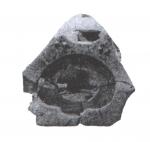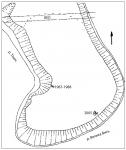Summary (English)
The Tripolye expedition of the Institute of Archaeology of the NAS of Ukraine renewed excavations at the settlement of Peschane in 2005. Previously excavations at this site were conducted in 1987-1988. The settlement has been known since 1890’s. Aerial photography (Shyshkin 1985) and geomagnetic surveys (conducted by Zagnij in 1980’s) resulted in a preliminary plan of the settlement structure.
During the 2005 field season a total area of 210 sq. m. was excavated. Two burnt houses of the Tripolye culture and one pit-house of the Penkivska culture were investigated. The remains of the Tripolye houses (so-called ploshchadka) are represented by compact clusters of burnt daub and pottery. They measure, respectively, 14.0 × 4.5 m and 10 × 4.5 m. The two-storeyed Eneolithic houses were ritually burnt. Preservation of the remains made possible the identification of their interiors – an altar, clay floors etc (Chernovol and Ryzhov 2006; Chernovol 2012). The majority of the finds is represented by table and cooking wares. Table wares mainly have monochromic black painted ornamentation. However, bichromic black and red ornamentation, as well as incised decoration were also noted. The main forms of the table wares are bowls, goblets, biconical and sphero-conical vessels, amphorae, pots and binocular vessels. Cooking wares are represented by pots and bowls. This collection also includes a unique find – a house model made of clay (Diachenko and Chernovol 2007: 41, fig. 1, 4). Analysis of the ceramic complex confirmed the relative date of the site, previously proposed by Ryzhov – this settlement belongs to the first phase of development of the Nebelivska local group (Ryzhov 1993).
The pit-house of the Penkivska culture included a stone oven of a size of 1.2 × 1.6 m. Rare artefacts are represented by sherds.
Archaeological materials are permanently kept in the State Cultural and Historic Preservation ‘Trypillia culture’, village of Legedzine, Talnivskyi rajon, Cherkaska oblast.
The major part of this summary is based upon Chernovol and Ryzhov 2006 / Основна частина тексту базується на роботі Chernovol and Ryzhov 2006.
Fig. 1: Location of the settlement and excavation-sites of 1987-1988 and 2005 (after Chernovol and Ryzhov 2006) / Рис. 1. Локалізація поселення з розкопами 1987-1988 рр. і 2005 р. (за Chernovol and Ryzhov 2006).
Fig. 2. House model from Pishchana (after Diachenko and Chernovol 2007) / Рис. 2. Модель житла з Піщаної (за Diachenko and Chernovol 2007).






![Download [PDF]](/excavation/skins/fasti/images/results/download_sml.png)
